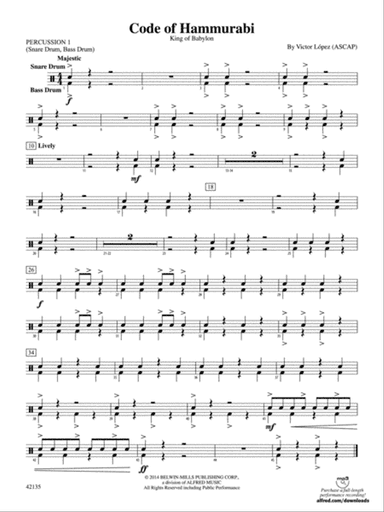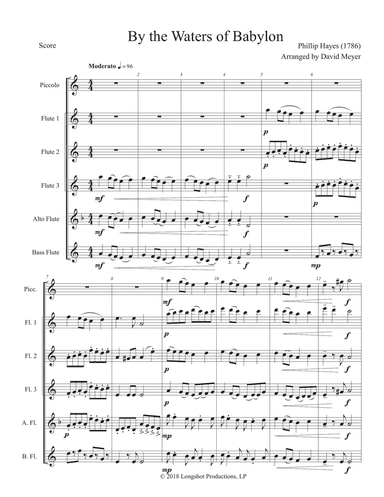Unavailable
Babylon is currently unavailable
We can no longer provide this arrangement through Sheet Music Stores. The listing stays online so you can learn about the piece and explore alternatives.
Try these next steps
- Discover similar sheet music curated for you below.
- Search for “Babylon” across our catalog.
About this arrangement
Choral SA choir, piano SKU: CF.BL1039 Composed by James DesJardins. Fold. Octavo. 12 pages. Duration 2 minutes, 28 seconds. BriLee Music #BL1039. Published by BriLee Music (CF.BL1039). UPC: 680160911509. 6.875 x 10.5 inches. Key: E phrygian. English. Traditional English Rhyme.The traditional rhyme How Many Miles to Babylon? has fascinated scholars for hundreds of years with its mysterious origins and hidden meanings. Some speculate that threescore miles and ten may refer to the journey of a lifetime. Candlelight may refer to the blissful innocence and lightness of youth, and Babylon may refer to a place of more knowledge, but less lightness. Meanwhile, others suggest that this text is just meant to be amusing and nothing more. The rhyme gained popularity as a singing game in Great Britain, and remained popular until the twentieth century. To play the game, two lines face each other and a tagging person stands in the middle. After performing the rhyme, lines must cross to the other side without being tagged. Tagged players join the original middle person and continue tagging. This setting brings a light, jazzy feel to the original rhyme, as well as some distinctive musical characteristics, which singers are meant to experience throughout the preparation process. Physical actions can clarify the meter of 5, which presents itself in a consistent pattern of 3 and then 2. For example, one might perform [pat-clap-clap, pat-clap] in a repeated pattern along with a verbal system of counting (i.e. DU-BAH-BEE, DU-BAY or 1-2-3, 1-2 or Straw-ber-ry, ice-cream). Active listening while moving to these patterns of 3 and 2 will offer singers the opportunity to internalize Babylon's unusual meter. Another distinctive quality of this piece is Phrygian tonality. One way to think of Phrygian is that the notes are centered around mi in the same way that the notes of major are centered around do. It sounds similar to minor, the biggest difference being a lower second scale degree. In this piece, that means we see F natural instead of F#. Singers dont need any theoretical understanding to naturally acquire the melody through listening. And, by studying a piece like this, performers can come to a deeper understanding of more familiar tonalities. Singers should take a light, playful vocal approach, matching the playful nature of the text and the jazz style of the music without sacrificing accuracy. Enjoy this captivating text in its jazzy setting.The traditional rhyme How Many Miles to Babylon?A has fascinated scholars for hundreds of years with its mysterious origins and hidden meanings. Some speculate that athreescore miles and tena may refer to the journey of a lifetime. Candlelight may refer to the blissful innocence and lightness of youth, and Babylon may refer to a place of more knowledge, but less lightness. Meanwhile, others suggest that this text is just meant to be amusing and nothing more. The rhyme gained popularity as a singing game in Great Britain, and remained popular until the twentieth century. To play the game, two lines face each other and a tagging person stands in the middle. After performing the rhyme, lines must cross to the other side without being tagged. Tagged players join the original middle person and continue tagging. This setting brings a light, jazzy feel to the original rhyme, as well as some distinctive musical characteristics, which singers are meant to experience throughout the preparation process. Physical actions can clarify the meter of 5, which presents itself in a consistent pattern of 3 and then 2. For example, one might perform [pat-clap-clap, pat-clap] in a repeated pattern along with a verbal system of counting (i.e. aDU-BAH-BEE, DU-BAYa or a1-2-3, 1-2a or aStraw-ber-ry, ice-creama). Active listening while moving to these patterns of 3 and 2 will offer singers the opportunity to internalize Babylon's unusual meter. Another distinctive quality of this piece is Phrygian tonality. One way to think of Phrygian is that the notes are centered around amia in the same way that the notes of major are centered around ado.a It sounds similar to minor, the biggest difference being a lower second scale degree. In this piece, that means we see F natural instead of F#. Singers donat need any theoretical understanding to naturally acquire the melody through listening. And, by studying a piece like this, performers can come to a deeper understanding of more familiar tonalities. Singers should take a light, playful vocal approach, matching the playful nature of the text and the jazz style of the music without sacrificing accuracy. Enjoy this captivating text in its jazzy setting.The traditional rhyme How Many Miles to Babylon? has fascinated scholars for hundreds of years with its mysterious origins and hidden meanings. Some speculate that "threescore miles and ten" may refer to the journey of a lifetime. Candlelight may refer to the blissful innocence and lightness of youth, and Babylon may refer to a place of more knowledge, but less lightness. Meanwhile, others suggest that this text is just meant to be amusing and nothing more. The rhyme gained popularity as a singing game in Great Britain, and remained popular until the twentieth century. To play the game, two lines face each other and a tagging person stands in the middle. After performing the rhyme, lines must cross to the other side without being tagged. Tagged players join the original middle person and continue tagging. This setting brings a light, jazzy feel to the original rhyme, as well as some distinctive musical characteristics, which singers are meant to experience throughout the preparation process. Physical actions can clarify the meter of 5, which presents itself in a consistent pattern of 3 and then 2. For example, one might perform [pat-clap-clap, pat-clap] in a repeated pattern along with a verbal system of counting (i.e. "DU-BAH-BEE, DU-BAY" or "1-2-3, 1-2" or "Straw-ber-ry, ice-cream"). Active listening while moving to these patterns of 3 and 2 will offer singers the opportunity to internalize Babylon's unusual meter. Another distinctive quality of this piece is Phrygian tonality. One way to think of Phrygian is that the notes are centered around "mi" in the same way that the notes of major are centered around "do." It sounds similar to minor, the biggest difference being a lower second scale degree. In this piece, that means we see F natural instead of F#. Singers don't need any theoretical understanding to naturally acquire the melody through listening. And, by studying a piece like this, performers can come to a deeper understanding of more familiar tonalities. Singers should take a light, playful vocal approach, matching the playful nature of the text and the jazz style of the music without sacrificing accuracy. Enjoy this captivating text in its jazzy setting.The traditional rhyme How Many Miles to Babylon? has fascinated scholars for hundreds of years with its mysterious origins and hidden meanings. Some speculate that "threescore miles and ten" may refer to the journey of a lifetime. Candlelight may refer to the blissful innocence and lightness of youth, and Babylon may refer to a place of more knowledge, but less lightness. Meanwhile, others suggest that this text is just meant to be amusing and nothing more. The rhyme gained popularity as a singing game in Great Britain, and remained popular until the twentieth century. To play the game, two lines face each other and a tagging person stands in the middle. After performing the rhyme, lines must cross to the other side without being tagged. Tagged players join the original middle person and continue tagging. This setting brings a light, jazzy feel to the original rhyme, as well as some distinctive musical characteristics, which singers are meant to experience throughout the preparation process. Physical actions can clarify the meter of 5, which presents itself in a consistent pattern of 3 and then 2. For example, one might perform [pat-clap-clap, pat-clap] in a repeated pattern along with a verbal system of counting (i.e. "DU-BAH-BEE, DU-BAY" or "1-2-3, 1-2" or "Straw-ber-ry, ice-cream"). Active listening while moving to these patterns of 3 and 2 will offer singers the opportunity to internalize Babylon's unusual meter. Another distinctive quality of this piece is Phrygian tonality. One way to think of Phrygian is that the notes are centered around "mi" in the same way that the notes of major are centered around "do." It sounds similar to minor, the biggest difference being a lower second scale degree. In this piece, that means we see F natural instead of F#. Singers don't need any theoretical understanding to naturally acquire the melody through listening. And, by studying a piece like this, performers can come to a deeper understanding of more familiar tonalities. Singers should take a light, playful vocal approach, matching the playful nature of the text and the jazz style of the music without sacrificing accuracy. Enjoy this captivating text in its jazzy setting.The traditional rhyme How Many Miles to Babylon? has fascinated scholars for hundreds of years with its mysterious origins and hidden meanings. Some speculate that “threescore miles and ten” may refer to the journey of a lifetime. Candlelight may refer to the blissful innocence and lightness of youth, and Babylon may refer to a place of more knowledge, but less lightness. Meanwhile, others suggest that this text is just meant to be amusing and nothing more.The rhyme gained popularity as a singing game in Great Britain, and remained popular until the twentieth century. To play the game, two lines face each other and a tagging person stands in the middle. After performing the rhyme, lines must cross to the other side without being tagged. Tagged players join the original middle person and continue tagging.This setting brings a light, jazzy feel to the original rhyme, as well as some distinctive musical characteristics, which singers are meant to experience throughout the preparation process. Physical actions can clarify the meter of 5, which presents itself in a consistent pattern of 3 and then 2. For example, one might perform [pat-clap-clap, pat-clap] in a repeated pattern along with a verbal system of counting (i.e. “DU-BAH-BEE, DU-BAY” or “1-2-3, 1-2” or “Straw-ber-ry, ice-cream”). Active listening while moving to these patterns of 3 and 2 will offer singers the opportunity to internalize Babylon's unusual meter.Another distinctive quality of this piece is Phrygian tonality. One way to think of Phrygian is that the notes are centered around “mi” in the same way that the notes of major are centered around “do.” It sounds similar to minor, the biggest difference being a lower second scale degree. In this piece, that means we see F natural instead of F#. Singers don’t need any theoretical understanding to naturally acquire the melody through listening. And, by studying a piece like this, performers can come to a deeper understanding of more familiar tonalities.Singers should take a light, playful vocal approach, matching the playful nature of the text and the jazz style of the music without sacrificing accuracy.Enjoy this captivating text in its jazzy setting.
Related sheet music

Code of Hammurabi: 1st B-flat Clarinet

Lay His Body Down - Orchestral Score and Parts
pepper choplin

By the Waters of Babylon
philip orem

Amoris divini et humana antipathia
antonio celso ribeiro

Code of Hammurabi: 1st B-flat Trumpet

Code of Hammurabi: 1st Percussion

From Babylon, All Saints Depart - a sacred hymn
kevin g. pace (ascap), mark r. fotheringham

Barefoot in Babylon

By the Waters of Babylon for Flutes

Rivers Of Babylon
boney m.

Babylon's Burning
the ruts
